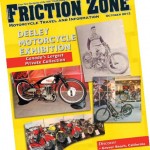The Deeley Motorcycle Exhibition—Canada’s Largest Private Collection
October 13th, 2012
The following is a reprint from Friction Zone Magazine and we thank them.
Mr. Motorcycle. Nearly everyone in Canada knew Frederick Trevor (Trev) Deeley by that nickname. After all, by the time he passed away at age 82 in March of 2002, he had six solid and very successful decades behind him of racing, selling, collecting, customizing, designing, and well, just generally promoting all things motorcycle. Trev Deeley was one of those individuals who managed to combine his birthright with passion, shrewd business acumen, fearlessness, and intelligence so spectacularly that he left behind not only an empire, but also a hefty legacy. In his case, the empire he built rests on Fred Deeley Ltd., which is the sole Canadian distributor (and the only one in the world not partially or wholly owned by the factory) of Harley Davidson motorcycles and branded merchandise. On the legacy side, Deeley also left behind Canada’s largest private collection of motorcycles—a 280-strong (and still growing) dream garage of machines that ranges across 60 marques and illustrates the long history of the Deeley’s involvement in the industry.
The Deeley Motorcycle Odyssey Friction Zone visited this collection, now called the Deeley Motorcycle Exhibition, recently, and while we will talk about that great experience more in a bit, a look at the highlights of Trev Deeley’s life in the industry is necessary beforehand.
The Deeley motorcycle odyssey began when Fred Deeley Sr., Trev’s grandfather, moved his family from Britain to Vancouver, Canada in 1914. Fred Sr. had built bicycles in his garage in England (a child-sized bike he built for Fred Jr is on display in the Exhibition) and he opened a small (just 12-feet-wide) bicycle and motorcycle shop downtown where both he and his son worked.
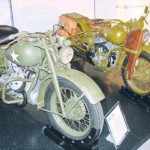
At the beginning of World War II, the U.S. War Department asked America’s motorcycle manufacturers to develop machines for military use. Harley-Davidson and Indian both produced war-time models, and while H-D would go on to manufacture over 90,000 of their WLA machines (the “A” stood for “Army”), Indian’s desert warfare specific 841 model (front) did not fare so well. Only about 1,000 of those were built and this model was never adopted for use.
Three years later, in 1917, Fred Deeley Ltd. is the first Canadian shop to start selling the Harley-Davidson line, which makes them the fourth-oldest H-D dealership in the world. (San Francisco’s Dudley Perkins dealership is the oldest.) In 1920, Frederick Trevor ‘Trev’ Deeley is born in Vancouver, and five years later, Fred Deeley Ltd. expands to include a second shop, run by Fred Jr., which also sells Austin cars from Britain. In 1935, 15-year-old Trev started working for his father as an apprentice mechanic, and soon had the itch to race. Racing quickly became his main passion, and from 1940 to 1955, he trailered his bikes to tracks all over North America, sometimes traveling thousands of miles each year. Once he got to those tracks, he often won, so much so that he earned a factory ride from Harley-Davidson and eventually rode (and wrenched) their machines in races ranging from hill climbs to flat track. He even made it to the beach course at Daytona in the late 1940s and early 1950s, which led to several 6,600-mile round-trip drives from Vancouver.
In 1948 during his first attempt on the sand, Trev’s Harley 45 WR seized and he finished in 72nd place. (The damaged rod and piston were promptly re-purposed to form the trophy for the annual Piston Run enduro event held by The Greater Vancouver Motorcycle Club, an outfit originally formed in 1922 by Fred Jr. and some friends. Now a hare scrambles and headed for its 65th anniversary in 2013, the Piston Run is still going strong.) Trev had greater success in Daytona in 1950, when he placed 10th, as well as in 1953, when he placed 13th while riding a BSA.
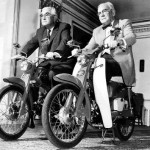
The Deeley’s late-1950s decision to import Hondas for sale was a risky one as the horrors of World War II’s Pacific battles were still fresh in everyone’s mind. This hilariously contrived photo op (indoors and on carpet) of Fred Jr and Sr on two of their new imports illustrates their ambivalence about this new business venture. Their grim expressions also lead one to think that maybe one didn’t ‘always meet
the nicest people on a Honda!’
Those podium misses were rare events for the Canadian, as he famously won races and set records in events all over Canada and the Pacific Northwest for several years. There is even a late-1940’s-era photo on display in the Deeley Motorcycle Exhibition that shows Trev (who raced with the #22 plate) surrounded by 22 first-place trophies from his early racing years.
By 1953, the younger Deeley had moved away from racing to focus more on the family business and had become the General Manager of Fred Deeley Motorcycles. In 1958, in a move that highlighted Trev’s business acumen and understanding of how the new Japanese bikes were going to change the motorcycle business, the Deeleys became the first importer of Hondas and Yamahas to an English-speaking market. That was a risky undertaking for two reasons: not only did anti-Japanese feeling still
run high after WWII, but Trev Deeley also managed to negotiate both deals without letting either firm know he was talking to the other.
In the end, the Deeleys only imported Japanese bikes for about 15 years. In 1973 and due in part to his longstanding relationship with Harley- Davidson, that company asked Trev to become the exclusive Canadian distributor of their machines and merchandise. Recognizing the opportunity for what it was (despite the fact that H-D was still slogging through the dark years of American Machine and Foundry (AMF) ownership at the time) Trev stopped importing the Japanese bikes and became the sole importer of Harley-Davidsons into Canada. The relationship proved to be so successful that, in 1985 Trev Deeley was invited to join the Milwaukee-based firm’s board of directors. He became one of the first three outside directors in The Motor Company’s history and served on that board for over a dozen years until retiring in 1993 at age 73. In 1995, he was inducted into the Canadian Motorsports Hall of Fame, and in 1999, he was inducted into the American Motorcyclist Association Hall of Fame “in recognition of his outstanding contributions to all aspects of motorcycling.”
Trev’s Collection Throughout all those years of racing bikes and working in the industry, Trev was also amassing an extensive collection of motorcycles. But in the early years, he had to keep his collecting habits under wraps. As Terry Rea, Exhibition historian and longtime friend of Trev’s, explains, “[Fred Jr.] did not believe in collecting motorcycles.
If it wasn’t saleable he would tell Trev to scrap it. Trev chose to hide them away and start his collection. “Later, once Trev was running things, there was no need for secrecy and he could save (and buy) what he wanted.
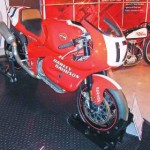
In 1994, Harley-Davidson selected Miguel Duhamel (whose father, Yvon, was sponsored by Trev Deeley
during a long and storied racing career) to race their new VR1000 in America’s AMA Superbike series. While the young Canadian racer was not able to post any wins with that bike, he did lead several races at times during that campaign—which were the only times a Harley-Davidson has ever led a race in that particular series.
The result is quite impressive—even though, for reasons of space, only about a third of the collection is on display at any one time inside the 60,000 square foot Trev Deeley Motorcycles Harley- Davidson dealership (1875 Boundary Road, Vancouver, BC). Roughly every other year or so, bikes are rotated in and out as the exhibition focuses upon a new theme. Past themes have included “End of Empire,” which showcased British bikes illustrating the rise and fall of that nation’s motorcycle industry, and “Classic Harley-Davidson,” which toured the long history of the manufacturer closest to Trev Deeley’s heart.
The current display, titled “Made in America,” covers the history of the motorcycle industry in this country. It is not too far removed from that earlier exhibition, as it features a heaping helping of H-D machines as well as quite a few Indians, a couple of Excelsiors, and a lone Buell. That bike, a 1998 S1 Lightning, set a new land speed record of 150.03 mph at Bonneville that year. The rider was Shane Kenneally, and the pit crew included Terry Rea (whose stories are worth a visit to the Exhibition alone), as well as a then-78-year-old Trev Deeley. Plainly, age never diminished Trev’s love for racing. Besides the Buell, there are several other interesting race bikes currently on display, many of which Trev raced himself. His 1949 H-D WR racer is there, with #22 placard attached, as well as his 1930 DAH Hillclimber—with the rear tire encased in chains for traction. More recent racing endeavors (as well as Trev Deeley’s long record of sponsoring racers) are represented by the likes of the distinctive orange 1994 VR1000 ridden by Miguel Duhamel at Daytona. While Trev never sponsored Miguel, he did sponsor that racer’s legendary father, Yvon, as well as racers like Barry Sheene, Steve Baker, and Jim Dunn. Trev’s passion for sponsoring racers was such that, as historian Rea notes, “One year, Trev took 22 riders to Daytona to race. They were all liveried in Deeley colors and the bikes were painted the same. This led many people to say ‘Who the Hell is Trev Deeley?’” Rea goes on to say, “Trev’s mechanic, Bob Work, got the idea to print some T-shirts up with that on it and Yamaha on the other side. They became a popular commodity.” While some of the bikes on display are rare, some are both rare and unusual. For example, a rather boxy looking H-D ‘Topper,’ which was that company’s one and only foray into the scooter market, sits on the big rotating turntable, while a very orange oddity stands alone not far away. This bulbous affair is a 1981 AMF Harley-Davidson NOVA prototype.
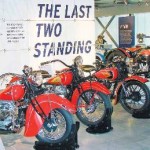
As the “Made in America” exhibit illustrates, the nation’s motorcycle manufacturers were not immune to the devastation of the Great Depression. By the mid 1930s, only Indian and Harley-Davidson were still in operation—and even they suffered from an inability to afford expensive materials, like chrome, for the manufacture of their bikes. But, as these Depression-era models indicate, both companies
were up to that challenge as they created lovely paint schemes to make up for the lack of ‘bling.’
Rea educates visitors about it by noting, “[This] project was an AMF endeavor trying to evolve Harley-Davidson into liquid-cooled, overhead-cammed motorcycles. The motorcycle was not well received by the dealers at a dealer show, so it was sent back to the drawing board. [It] evolved to the VR1000 race bike. When it was perfected it became the V-Rod. The Harley- Davidson factory saw fit to give us one [of the prototypes] to commemorate the passing of Trev in 2002.” While 12 were originally constructed, Rea believes that there are only six or seven left. As befits an exhibit titled “Made in America,” most of the bikes displayed are American-made. However, a couple of stand-outs sit right at the front of the exhibit and are notable not only for what they are, but also what they represent as regards the future of the collection. Both sit right inside the entrance, and the first is a very nice museum replica of a 1894 Hildebrand & Wolfmüller—the first two-wheeled vehicle to be referred to as a ‘motorcycle’ (or motorrad in German).
Next to it stands a brand new and stunning reproduction of an 1885 Daimler Reitwagen. Reportedly made from the original plans owned by Mercedes-Benz, this beautiful wood and brass machine represents the first gasoline-powered internal-combustion motorcycle ever produced. Both bikes require extended viewing to fully absorb their revolutionary qualities, and both (along with the lovely 1906 Indian ‘Camelback’ in the exhibit) were purchased by the collections’ new owners: Don James and Malcolm Hunter.
The two men are long-time business partners of Trev Deeley’s, and James succeeded Deeley both as Chair and CEO of Deeley Harley-Davidson Canada as well as on The Motor Company’s board of directors. Since no motorcycle collection should remain stagnant, it is nice to see that the Deeley Motorcycle Exhibition will continue to grow, evolve, and be worth a visit for a long time to come.
Note by Kate Edwards: At Terry Rea’s suggestion, we stayed at the Accent Inn Burnaby two blocks from the Deeley Motorcycle Exhibition. These reasonably priced lodgings (there are five Accent Inns scattered around southern British Columbia) deserve mention for their attention to the needs of traveling motorcyclists. They provide laundry facilities as well as rags and a place to wash your bike.
Additionally, they have a shuttle that will both deliver and retrieve you from nearby eateries—perfect for those of us who like a tall, cold one at the end of a long day’s ride.
Article by Kate Edwards
